Dragon fruit, also known as pitaya, is a tropical fruit with a unique appearance and pretty cool name. With its bright pink or yellow skin and green scales, dragon fruits look exotic but are they as good to eat as they look? Let’s find out.
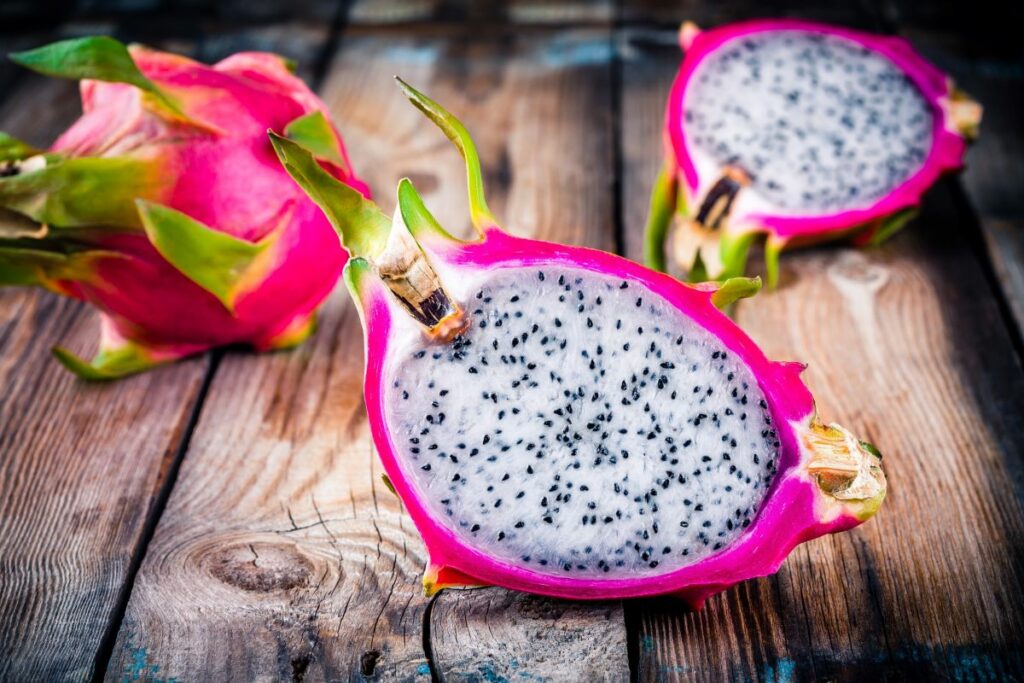
Related: Star Fruit (Carambola): How To Eat it and What it Tastes Like
Table of Contents
First, What Is Dragon Fruit?
If you have only just discovered dragon fruit, you might be interested to know they are a type of cactus fruit.
They come in a few varieties with the most common types being the red dragon fruit, which has vibrant red or pink skin, and the yellow dragon fruit, which has bright yellow or orange skin.
Dragon fruit are oval-shaped and typically 4-6 inches (10-15 cm) long. While the largest variety of dragon fruit can weigh around 2 pounds, they usually weigh between 10.5-23 oz (300-650g) when you purchase them from a supermarket.
Inside, the fruit has white flesh, speckled with tiny black seeds.
Dragon fruit is native to Central America but is now grown in many other regions as well. If you live in the right climate, you can grow your own dragon fruit.
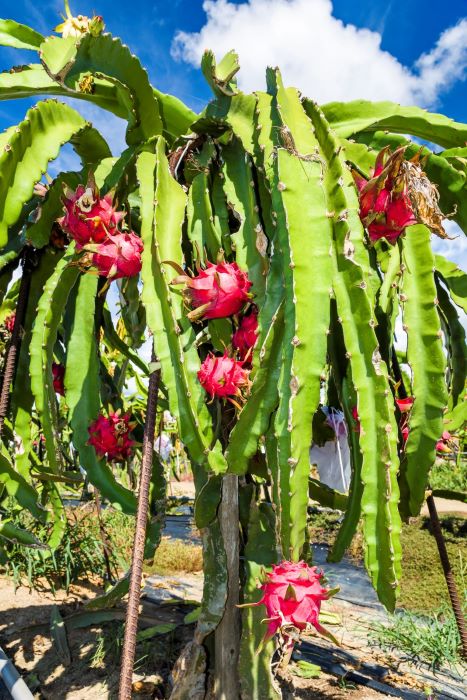
The red dragon fruit is the most commonly found variety. It has vibrant red or pink skin that is covered in scales resembling those of a dragon, hence the name. The skin is usually thick and can be easily peeled off.
Underneath, the flesh is white with a slightly sweet flavor. The inside texture is often compared to that of a kiwi, with a soft and juicy consistency. The flesh is speckled with numerous tiny black seeds, which are edible.
The yellow dragon fruit, on the other hand, has a bright yellow or orange skin. This variety is less common than the red but equally delicious. The yellow dragon fruit also has white flesh, similar in taste and texture to the red variety.
Some folks find the yellow dragon fruit slightly sweeter than the red variety.
What Does Dragon Fruit Taste Like?
Dragon fruit has a subtle, mildly sweet flavor that is often compared to a cross between a melon and a pear and is sometimes known as a strawberry pear. Its texture is smooth and juicy, similar to a kiwi but without the fuzz.
The black seeds add a satisfying crunch to each bite. The vibrant pink or white flesh of dragon fruit is refreshing and slightly tangy, with a hint of floral notes.
Dragon fruit has a unique taste that is both refreshing and mildly sweet, making it a popular choice for adding to desserts, smoothies, and salads.
Some argue that the taste of dragon fruit does not live up to its exotic appearance. And while I do agree with this, once you’ve adjusted your expectations (because they really do look so amazing!), you can appreciate dragon fruit’s subtle and refreshing nature.
The Different Types of Dragon Fruit
Dragon fruit comes in a number of varieties, each distinguished by its unique characteristics and flavor profiles. Some of the most sought-after dragon fruit varieties are:
1. White-Fleshed Dragon Fruit (Hylocereus undatus). Often referred to as Pitaya blanca, this is the variety of choice in supermarkets. It features a striking pink or red exterior and white flesh peppered with tiny black seeds. The flavor of the white-fleshed dragon fruit is mild and delicately sweet, offering subtle notes reminiscent of kiwi and pear.
2. Red-Fleshed Dragon Fruit (Hylocereus costaricensis). Known as Pitaya roja or Pitaya purpura, this variety dazzles with its vibrant red or magenta skin and vivid red flesh. Its taste leans towards the sweeter side and presents a berry-like essence, akin to the refreshing notes of watermelon.
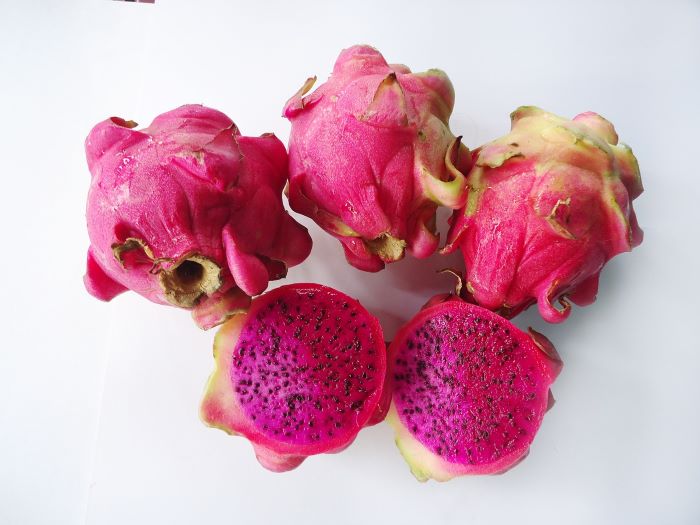
3. Yellow Dragon Fruit (Hylocereus megalanthus). Also recognized as Pitaya amarillo, this dragon fruit variety features a yellow exterior and pale white flesh. It has a sweeter taste in comparison to the white-fleshed type, with subtle hints of pineapple and citrus.
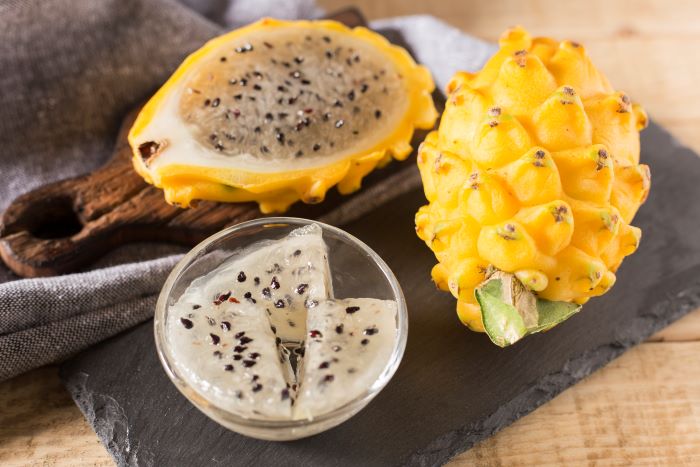
Where To Buy Dragon Fruit
Dragon fruit is becoming more widely available in grocery stores and markets so you might easily find it there. If not, you can try a local Latin American or Asian store.
Even some of the larger retailers will stock dragon fruit these days but you will need to check their specialty produce section.
You can also find dragon fruit online or at specialty fruit stores.
An alternative to fresh dragon fruit is to purchase it frozen from your supermarket, or even canned which are readily available. These can be great for smoothies or sorbets.
Dragon fruit also comes in chip form you can eat as a snack or as a freeze-dried powder form which can be added to your recipes or to garnish your dishes. Freeze-dried pieces also come in snacks.
How to Tell Your Dragon Fruit is Ripe
To check if your dragon fruit is ripe, give it a gentle squeeze. It should have a slight give without being too soft. The skin should be bright and vibrant in color, with no blemishes or soft spots.
You can give it a gentle sniff near where the stem was. If it has a pleasant, sweet aroma, it is likely ripe. If there is no smell, it’s probably not ripe yet.
A ripe dragon fruit will also feel heavier than an unripe one due to its moisture content.
How to Cut Dragon Fruit Like a Pro
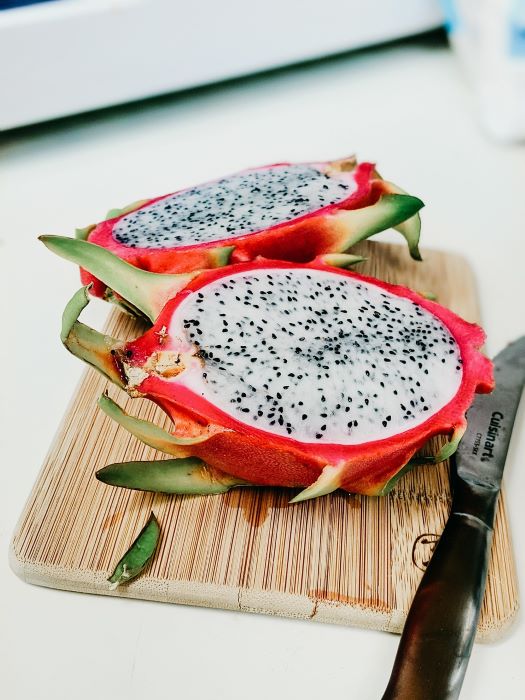
To cut a dragon fruit, start by washing it thoroughly under running water.
Then, use a sharp knife to cut the fruit in half lengthwise. You will see the white flesh with tiny black seeds inside.
After cutting the dragon fruit in half, use a spoon to scoop out the flesh from each half. Drag the spoon along the edges of the fruit, separating the flesh from the skin. Be gentle for this part, to avoid damaging the flesh.
Once all the flesh is separated, you can cut it into slices, cubes, or any desired shape.
If you prefer, you can eat the dragon fruit as is, or use it in various recipes such as smoothies, salads, or desserts. Just make sure to remove any remaining skin before eating it as the skin is not edible.
How to Eat Dragon Fruit with Recipe Ideas
To eat a dragon fruit, use a spoon to scoop out the flesh from the skin after cutting in half using the instructions above.
The flesh is juicy and sweet, with a subtle flavor. You can eat dragon fruit as it is, or you can give it a little additional sweetness with a drizzle of honey. You don’t need a lot, but it can provide a bit of extra sweet flavor.
The skin of the dragon fruit is not edible, so make sure to discard it.
Dragon fruit can also be juiced or used to make tea. The dragon fruit plant flowers can also be eaten or used to make tea.
You can also use your dragon fruit in one of these recipe suggestions.
Fruit Salad with Dragon Fruit
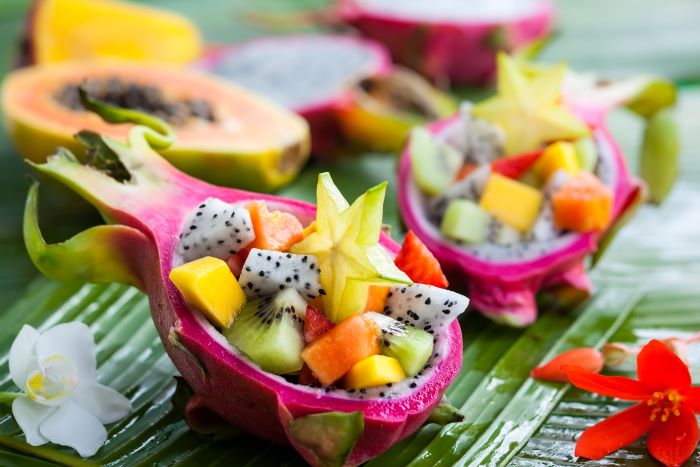
Simply chop the dragon fruit into bite-sized pieces and mix it with other fruits to create a colorful and refreshing fruit salad.
Fruits that pair well with dragon fruit in fruit salad include pineapple, mango, kiwi, strawberries, other berries such as blueberries and raspberries, oranges, cantaloupe, honeydew and grapes.
Drizzle citrus or a honey-lime dressing to enhance the flavors and bring your fruit salad to life.
Check out these recipes:
Dragon Fruit Smoothie
For a dragon fruit smoothie, you can blend the dragon fruit flesh with your choice of other fruits, such as bananas or berries, along with milk, milk alternative (my favorite is oat milk) or yogurt to make a delicious and nutritious smoothie.
For added sweetness, you can use honey or agave nectar. And the addition of chia seeds or flaxseeds with provide fiber. You can also add in protein powder. While lemon or lime can brighten the flavors with a burst of citrus.
Here are some dragon fruit smoothie recipes to try:
- Dragon Fruit Smoothie (11g Protein)
- Dragon Fruit and Goji Berry Smoothie
- 5-Minute Dragon Fruit Smoothie
Dragon Fruit Desserts
Dragon fruit can be added to various desserts, such as cakes, tarts, or sorbets. You can dice it, puree it, or use it as a decorative element.
- Dragon Fruit Cake
- Dragon Fruit Cheese Cake
- Mango and Pitahaya Fruit Tart
- Dragon Fruit & Small Lime Sorbet
Dragon Fruit Nutrition and Health Benefits
There’s a lot to love about dragon fruit. Not only is it delicious but dragon fruit is also good for you.
It is low in calories while also being high in fiber.
Specifically, the United States Department of Agriculture (USDA) states 100g of dragon fruit is 60 calories with 2.9g of fiber.
Dragon fruit is also high in antioxidants and vitamin C, and the tiny black seeds are a good source of omega-3 fatty acids.
Related:
